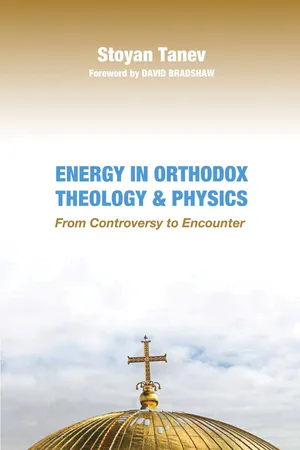![]()
Part I
Divine Essence, Energy, and the Sophiological Controversy
![]()
Chapter 1
Fr. Georges Florovsky and the Rediscovery of the Distinction between Divine Essence and Energies in Modern Orthodoxy
According to A. Klimoff, Florovsky viewed Soloviev’s influence on Russian intellectual history as “unequivocally pernicious.” This statement however should not be interpreted in a simplistic one-sided way. Florovsky was fully aware of the evolution of Soloviev’s thought and had perhaps his own evolution in interpreting Soloviev’s works and role as a Russian religious thinker. For example, in his early publications, Florovsky defended Soloviev as a genuine voice of Orthodox catholicity promoting a genuine synthesis of faith and understanding. He significantly revised however his judgment by the early 1920s, distinguishing sharply his own conception of synthesis from Soloviev’s synthesis of All-Unity. Florovsky pointed out that while Soloviev’s earlier philosophy of All-Unity was marked by a certain pantheism and Gnosticism, his Tale of the Antichrist represented a second metaphysic in Soloviev’s thought, which could be considered as a philosophy of miracle and struggle. According to Fr. Matthew Baker, “Florovsky contrasts two syntheses: the pan-logism of Soloviev’s synthesis of All-Unity, and the new synthesis suggested by the ‘Tale of the Anti-Christ,’ grounded on the vision of the historic Christ.” For Fr. Matthew this is a clear indication that Florovsky’s own neo-patristic synthesis took its starting point precisely where he thought Soloviev’s last vision left off.
In spite of Florovsky’s subtlety in interpreting the works of Soloviev, he considered Bulgakov’s sophiology (which he saw as strongly influenced by Soloviev’s philosophy of All-Unity) as an unnecessary and, actually, a dangerous attempt to develop a philosophically-driven, non-patristic alternative of the Christian teaching on creation ex nihilo and the Trinitarian relationship between God, man, and the world. He remained deeply respectful towards Bulgakov, but passionately, although not personally, rejected his most fundamental ideas as wrong and harmful to the Church. Interestingly, in this indirect debate with Bulgakov it was not the understanding of Sophia but its implication for the Christian dogma on creation out of nothing that emerged as the real stumbling block. Bulgakov addressed the doctrine of creation from a sophiological point of view. Florovsky, addressed the doctrine of creation within the context of his “neo-patristic” synthesis by focusing on the distinction between Divine essence and will and, respectively, between Divine essence and energies. By doing so he contributed to the rediscovery of the teaching on the Divine essence and energies and provided a theological reflection that became the source of the key Orthodox theological themes in the twentieth century. In this sense, “one cannot really understand Florovsky’s ‘neo-patristic’ synthesis without understanding that in the background lurks Bulgakov,” i.e., Florovsky’s theology, including his first emphasis on the relevance of the distinction between Divine essence and energy, was articulated in opposition to Bulgakov’s thought.
It should be pointed out therefore that the key reason for the rediscovery of the teaching of the Divine essence and energies was (as it was in the middle of the fourteenth century) deeply theological. This fact seems to be currently diluted by arguments about the existence of special personal motives of the Russian émigré theologians in Paris in the 1920s who were trying to build a unique theological identity within the context of their new non-Orthodox cultural environment. Without any doubt, such motives might have had some relevance. However, as we shall see, the theological issues were the key reason for the need to recapture the theology of St. Gregory Palamas.
In fact, it was Bulgakov’s specific (non-patristic) interpretation that forced Fr. George Florovsky to engage in reaffirming the place of St. Gregory “within mainline patristic tradition, in this sense refuting Bulgakov’s claim that St. Gregory can be seen as one of the originators of Sophiology.” Bulgakov’s reading of St. Gregory Palamas was driven by a very specific context—his commitment to provide a theological defense for the Name-Worshipers at the Russian Church Council of 1917–18. The Name-Worshipers were Russian monks on Mount Athos that were associated with a controversy (1912–13) due to their claim that the name of God was God Himself. The monks believed that they follow the theology of St. Gregory Palamas. This belief was expressed for the first time by Hieromonk Anthony Bulatovich (1870–1919), who wrote an Apology of Faith in the Name of God and the Name Jesus, which was distributed at first in lithographic form and later printed in St. Petersburg (1913) with the help of Fr. Pavel Florensky and M. A. Novoselov. As it appears, it was Fr. Pavel Florensky who was the first among Russian clergymen and intellectuals to pay a closer attention (through the discussions with Anthony Bulatovich) to the theology of St. Gregory Palamas. According to T. Sénina, Anthony Bulatovich learned about the theology of St. Gregory Palamas most probably from the Russian scholar of Byzantine studies Ivan Ivanovich Sokolov who in 1911 published a review of the recently published book by G. Papamichael dedicated to St. Gregory Palamas: Ὁ ἅγιος Γρηγόριος Παλαμᾶς ἀρχιεπίσκοπος Θεσσαλονίκης. According to N. Pavlyuchenkov however, the rediscovery of Palamite theology and the teaching on the distinction between essence and energies should be clearly attributed to Fr. Pavel Florensky, and it was from him t...
